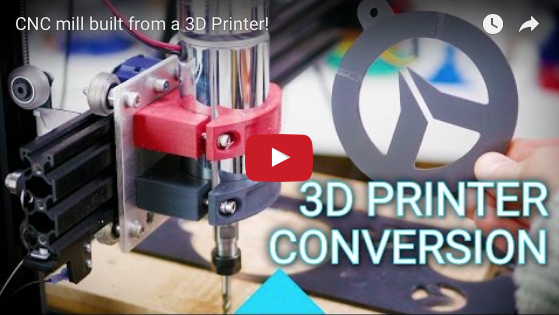 In recent years the manufacturing world has seen numerous hybrid additive-subtractive machines. These generally are in the form of a 3D printing head combined with a CNC machining center: the additive is added. But creative additive enthusiast Thomas Sanladerer has come at the idea from the opposite direction: he has started with a 3D printer and transformed it to be able to function as a CNC mill.
In recent years the manufacturing world has seen numerous hybrid additive-subtractive machines. These generally are in the form of a 3D printing head combined with a CNC machining center: the additive is added. But creative additive enthusiast Thomas Sanladerer has come at the idea from the opposite direction: he has started with a 3D printer and transformed it to be able to function as a CNC mill.
There are pluses and minuses in making a 3D printer into a mill. It took more than replacing a printing head with a milling tool. Al Williams at the Hackaday website noted the challenges: "A CNC tool probably weighs more than a typical hotend. In addition, cutting into solid material generates a lot of torque." Sanladerer took pains to beef up a MendelMax 3 3D printer.
You can see Sanladerer's YouTube video about his creation here; the Hackaday feature is here.
Related Glossary Terms
- computer numerical control ( CNC)
computer numerical control ( CNC)
Microprocessor-based controller dedicated to a machine tool that permits the creation or modification of parts. Programmed numerical control activates the machine’s servos and spindle drives and controls the various machining operations. See DNC, direct numerical control; NC, numerical control.
- gang cutting ( milling)
gang cutting ( milling)
Machining with several cutters mounted on a single arbor, generally for simultaneous cutting.
- milling
milling
Machining operation in which metal or other material is removed by applying power to a rotating cutter. In vertical milling, the cutting tool is mounted vertically on the spindle. In horizontal milling, the cutting tool is mounted horizontally, either directly on the spindle or on an arbor. Horizontal milling is further broken down into conventional milling, where the cutter rotates opposite the direction of feed, or “up” into the workpiece; and climb milling, where the cutter rotates in the direction of feed, or “down” into the workpiece. Milling operations include plane or surface milling, endmilling, facemilling, angle milling, form milling and profiling.
- milling machine ( mill)
milling machine ( mill)
Runs endmills and arbor-mounted milling cutters. Features include a head with a spindle that drives the cutters; a column, knee and table that provide motion in the three Cartesian axes; and a base that supports the components and houses the cutting-fluid pump and reservoir. The work is mounted on the table and fed into the rotating cutter or endmill to accomplish the milling steps; vertical milling machines also feed endmills into the work by means of a spindle-mounted quill. Models range from small manual machines to big bed-type and duplex mills. All take one of three basic forms: vertical, horizontal or convertible horizontal/vertical. Vertical machines may be knee-type (the table is mounted on a knee that can be elevated) or bed-type (the table is securely supported and only moves horizontally). In general, horizontal machines are bigger and more powerful, while vertical machines are lighter but more versatile and easier to set up and operate.

